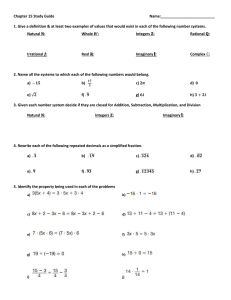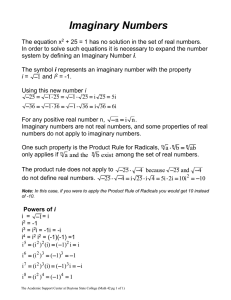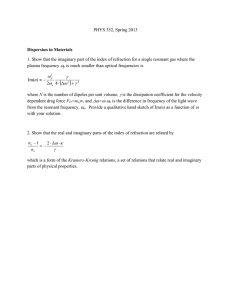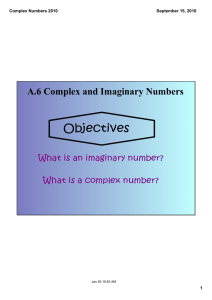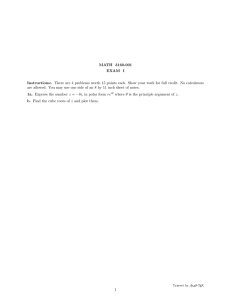Document
advertisement
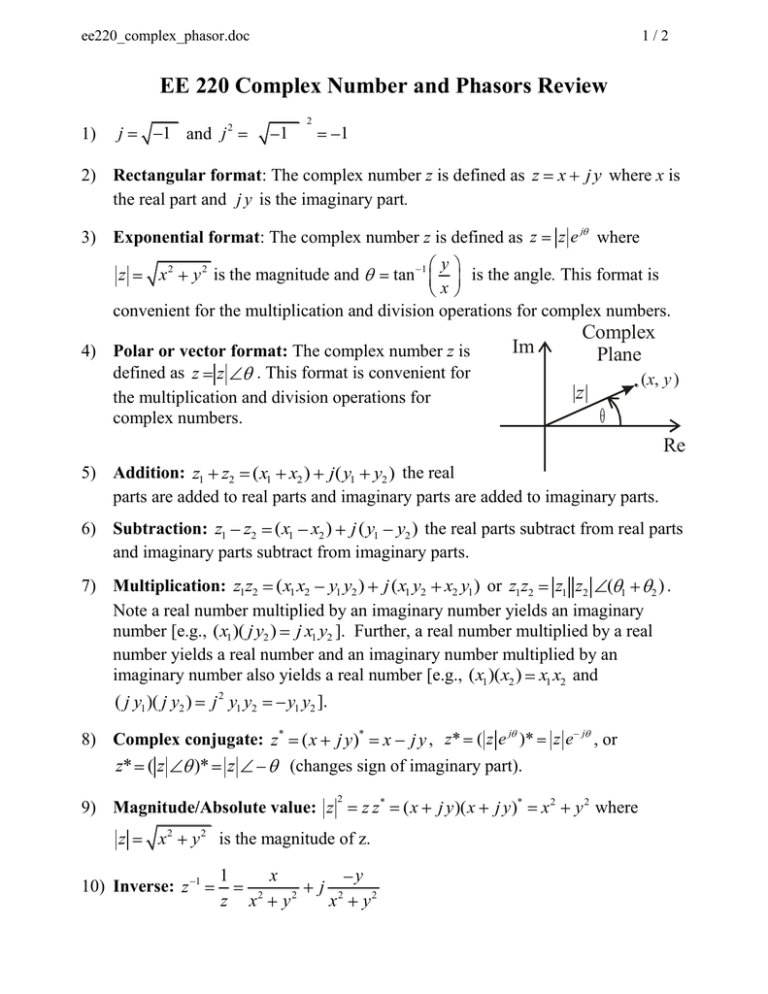
ee220_complex_phasor.doc
1/2
EE 220 Complex Number and Phasors Review
1)
j
2
1 and j 2
1
1
2) Rectangular format: The complex number z is defined as z
the real part and j y is the imaginary part.
x
j y where x is
3) Exponential format: The complex number z is defined as z
z e j where
y
is the angle. This format is
x
convenient for the multiplication and division operations for complex numbers.
z
x2
y 2 is the magnitude and
tan
1
4) Polar or vector format: The complex number z is
defined as z z
. This format is convenient for
the multiplication and division operations for
complex numbers.
Complex
Plane
Im
(x, y )
|z|
Re
5) Addition: z1 z2 ( x1 x2 ) j( y1 y2 ) the real
parts are added to real parts and imaginary parts are added to imaginary parts.
6) Subtraction: z1 z2 ( x1 x2 ) j ( y1 y2 ) the real parts subtract from real parts
and imaginary parts subtract from imaginary parts.
7) Multiplication: z1z2 ( x1 x2 y1 y2 ) j ( x1 y2 x2 y1 ) or z1z2 z1 z2 ( 1 2 ) .
Note a real number multiplied by an imaginary number yields an imaginary
number [e.g., ( x1 )( j y2 ) j x1 y2 ]. Further, a real number multiplied by a real
number yields a real number and an imaginary number multiplied by an
imaginary number also yields a real number [e.g., ( x1)( x2 ) x1 x2 and
j 2 y1 y2
( j y1 )( j y2 )
y1 y2 ].
8) Complex conjugate: z* ( x j y)* x j y , z* ( z e j )*
(changes sign of imaginary part).
z* ( z
)* z
9) Magnitude/Absolute value: z
z
x2
10) Inverse: z
2
z z*
y 2 is the magnitude of z.
1
1
z
x
x2
y2
j
x2
y
y2
(x
j y )( x
j y )*
ze
x2
j
, or
y 2 where
ee220_complex_phasor.doc
11) Division:
z1
z2
z1 z2
2/2
x1 x2
2
x2
1
y1 y2
2
y2
j
x2 y1
2
x2
z1
z2
x1 y2
2
y2
1
2
z1
z2
12) The Real operation: Re( z) x and Imaginary operation: Im( z)
magnitude of the real and imaginary parts of a complex number.
13) Square root:
z
14) Euler's Identity: e
z
2
j
cos
z
(
1
2
).
y yield the
2
j sin
where e
j
cos2
sin 2
1
Im
(cos
sin
sin
1
Re
cos
15) Phasors (AKA: frequency-domain): complex numbers can be used to represent
time-domain sinusoids. Here, the sinusoid x(t ) Acos( t
) is represented as
X Ae j A . The t time dependence is implied. Phasors for sinusoids at
the same frequency can make adding, subtracting, multiplying, and dividing
sinusoidal functions much easier; phasors are treated like any complex numbers.
16) To convert phasors back to the time-domain sinusoids they represent:
a. multiply the phasor ( Ae j or A
) by e j
t
or 1
t,
b. apply Euler's Identity, and
c. find/keep the real part using the Re( ) operation.
Re{ Ae j e j t } Re{ Ae j (
e.g.,
)
}
Re{ A cos( t
A cos( t
17) Derivative:
t
d v(t )
dt
18) Integral: v(t ) dt
j V
V
j
)
)
j A sin( t
)}


